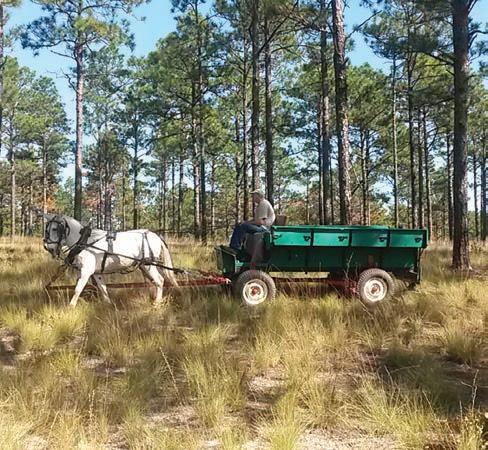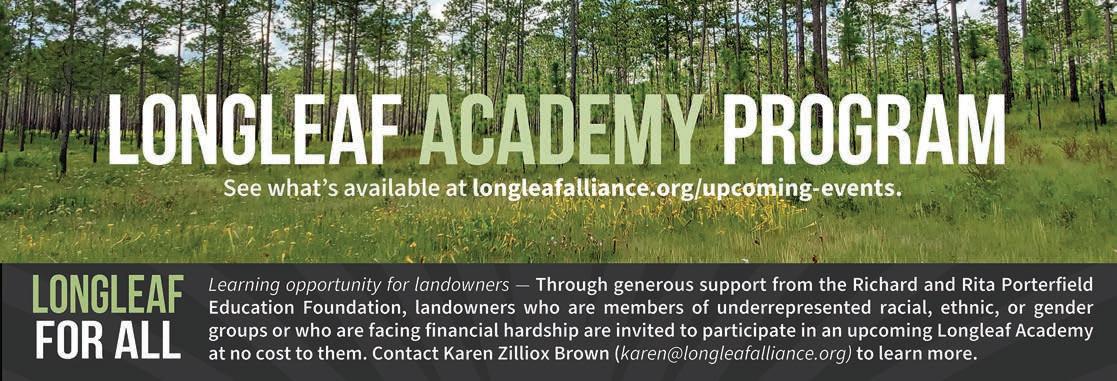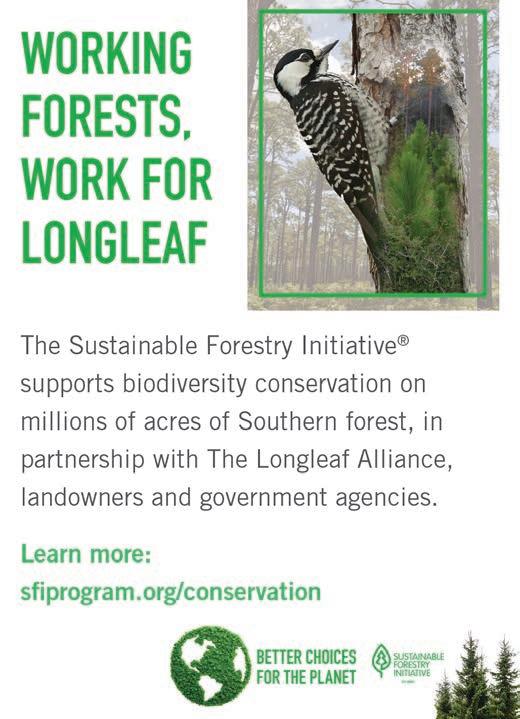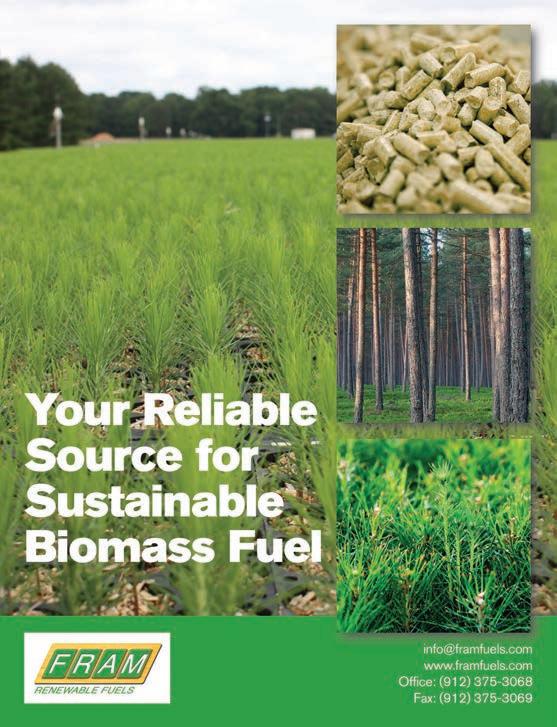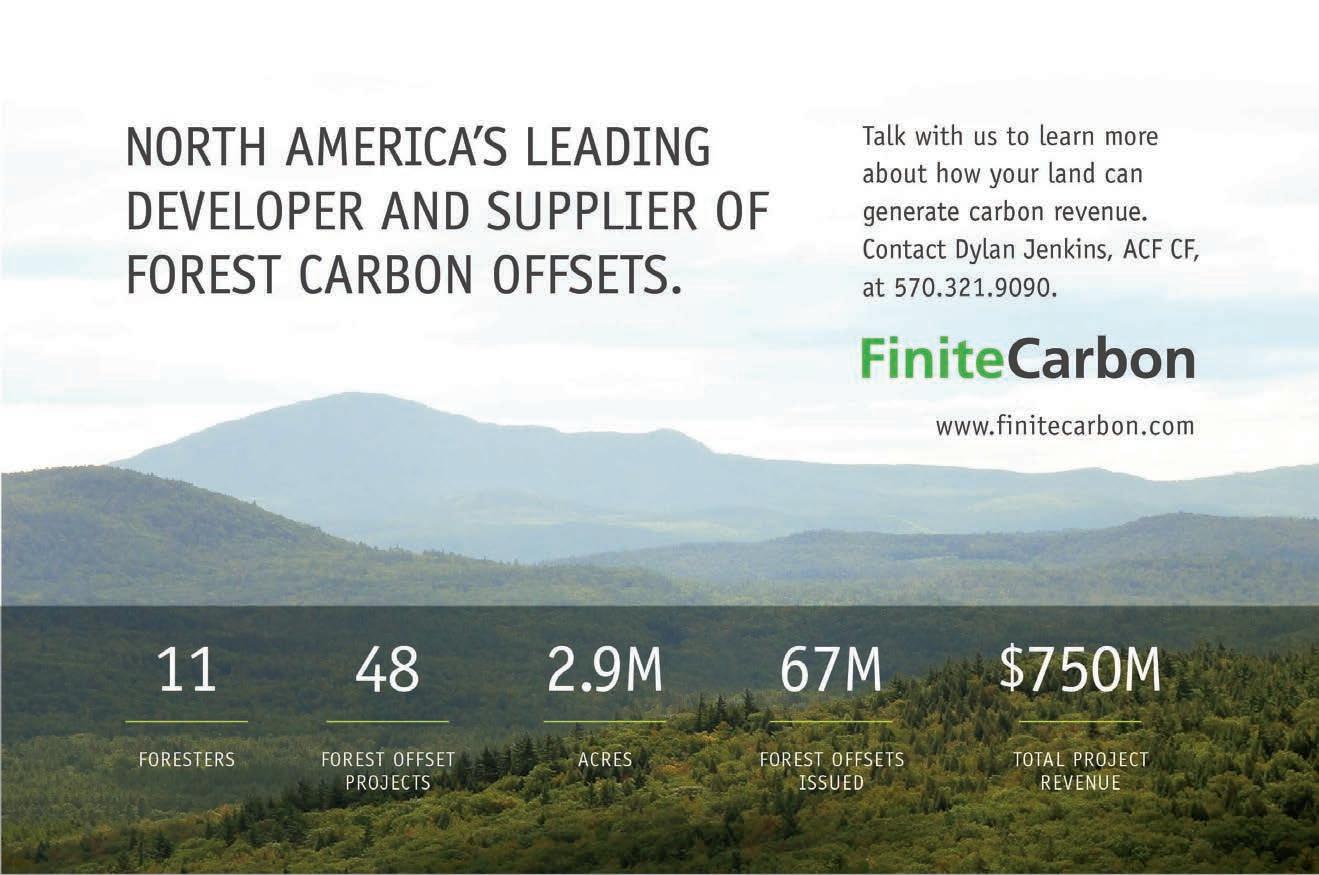
20 minute read
REGIONAL UPDATES
By Colette DeGarady, The Nature Conservancy, Longleaf Partnership Council Chair
News from the Longleaf Partnership Council
Advertisement
Colette DeGarady monitoring new plant growth at Sandy Island Preserve in South Carolina one month after a wildfire in 2009. Photo by Tom Johnson.
I received a perfect assignment prior to stepping into the Longleaf Partnership Chair role. The U.S. Forest Service asked if I would document America’s Longleaf Restoration Initiative (ALRI) as a model of Shared Stewardship. I have been participating with ALRI since 2012, but this exercise of reviewing the evolution of ALRI and summarizing why our collaboration is a model for others increased the pride and purpose I felt in being part of the Longleaf Partnership Council Leadership Team. Some components of this report include: • How ALRI formed and why the initial Conservation Plan was a critical component • Suggested elements for establishing and maintaining a successful collaborative • Description of the 3-tiered governance structure for ALRI
This document, America's Longleaf Restoration Initiative Shared Stewardship Performance Pilot, is now available online at americaslongleaf.org under Resources (Rangewide History and Policy publications). It not only provides a good summary of our work to new and existing participants in ALRI but also is a tool for other collaboratives to use when thinking through successful elements needed to drive partnerships forward in meeting a common goal.
In my current role with The Nature Conservancy as the Longleaf Pine Whole System Director, I work with teams across the 9-state historic range to boost the enabling conditions to accomplish longleaf protection, management, and restoration. Before taking this regional position, I helped create and lead one of the Local Implementation Teams (Sewee Longleaf Conservation Cooperative), where I gained useful experience in facilitating and planning steering committee meetings, landowner engagement, and implementation of longleaf projects. Now I carry that on-the-ground experience in my mind as I work toward influencing partnerships, policy, and resources on a broader scale.
Some of the work on the horizon for 2022 includes: continuing consistent communication around the resilience and co-benefits of longleaf pine forests, advancing the work of the Longleaf for All working group, proceeding with the execution of an updated Longleaf Resource Value map to inform the next Conservation Plan for ALRI, and scheduling an in-person Longleaf Partnership Council (LPC) meeting. I look forward to following an impressive group of leaders who have filled the role of LPC Chair and building on the large body of work in motion.
Longleaf for All Marks First Year of Accomplishments

In less than a year, America’s Longleaf Restoration Initiative’s (ALRI) newest working group, Longleaf for All, is seeing incredible results in the forestry outreach community. Longleaf for All utilizes ALRI’s network and platform to increase minority participation in forestry-related programs, practices and activities, and help landowners reap the economic, ecological, and cultural benefits of owning forested land. In the past calendar year (2021), Longleaf for All achieved the following results: • Formed a highly effective working group consisting of 23 participants from various organizations and entities formed to engage and guide Longleaf for All. This group has convened five times (as of October 2021) through highly interactive virtual meetings and identified challenges facing minority landowners and professionals, as well as recommendations and networks that have led to potential on-the-ground results through the development of demonstration projects. • Developed a charter to officially guide the leaders and working group on goals and outcomes by setting an annual plan of work, approved by the Longleaf Partnership
Council (LPC) and Longleaf Federal Coordinating
Committee. • Created a Barriers and Recommendations document detailing the challenges that face minority landowners, as well as guidance and action steps to address these challenges. The four main categories include: 1) Property rights; 2) Property size and scale of properties; 3) Access to capital, resources, and markets; and 4) Outreach challenges from distrust and disconnection. • A number of these recommendations have already been integrated into ALRI’s 2022-2024 Strategic Priorities and
Actions document, and these recommendations are being provided to ALRI and partners with additional plans forming for implementation and next steps. • USDA Natural Resources Conservation Service (NRCS) provided data on historical participation in the Farm Bill
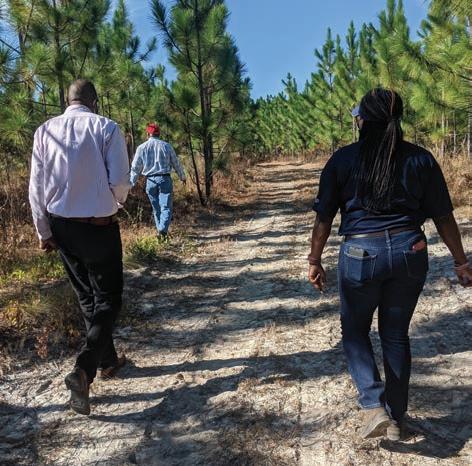


Members of Longleaf for All walk along a fire break in a longleaf stand. Photo by Tiffany Woods. Herbert Hodges, a landowner in South Georgia working on one of Longleaf for All’s demonstration projects, shows a longleaf tract to Vontice Jackson (NRCS) and Tiffany Woods. Photo by Luther Jones.
program to identify gaps and areas to prioritize in the future. The Longleaf for All Committee has requested additional NRCS granular data to pinpoint the locations to target our efforts. • Demonstration Projects: On behalf of Longleaf for All,
National Wildlife Federation (NWF) applied for funding for two shovel-ready projects: o Herbert Hodges Demonstration Forest: NWF and NRCS Georgia are working together to develop a model farm in South Georgia with Mr. Herbert Hodges. Work is scheduled to start in the fall of 2021, with outreach events planned to begin spring of 2022 including a “Learn and Burn” and workshop focusing on estate planning. o Hoke County Community Forest: NWF was awarded a grant from the National Fish and Wildlife Foundation through the Longleaf Landscape Stewardship Fund to work with project partners (including the Sandhills Prescribed Burn Association and The Longleaf Alliance, among many others) to restore longleaf pine on a community-owned forest in Hoke County, North Carolina. Grant funds will support longleaf pine restoration activities, including wiregrass and longleaf seedling plantings on the forest. This Community Forest will generate timber sale revenue that will go directly to the citizens of Hoke County, which is a minority-majority county. Funders of this project include: Altria, U.S. Department of Defense, USDA- NRCS, U.S. Forest Service, and NRCS North Carolina. Another significant accomplishment has been the level of engagement, excitement, and camaraderie that Longleaf for All has brought to the ALRI, forestry, and minority outreach community. In a challenging period from the COVID-19 pandemic, this working group has brought individuals together and garnered new levels of excitement from the many meetings and presentations thus far. One individual that has worked in minority outreach perhaps captured it best by saying: “I’ve waited my entire career to work on a project like this.”
Longleaf for All Working Group Members:
Ryan Bollinger, The Longleaf Alliance ● Sam Cook, North Carolina State University ● Freddie Davis, Federation of Southern Cooperatives ● Jacqueline Davis-Slay, USDA, Office of Partnerships and Public Engagement ● Colette DeGarady, The Nature Conservancy ● Amadou Diop, USDA Forest Service Southern Region ● Amelia Dortch, USDA NRCS ● Chris Erwin, American Forest Foundation ● Jennifer Fawcett, North Carolina State University ● Mavis Gragg, Sustainable Forestry and African American Land Retention Program ● Stephanie Hertz,* Texas A&M Natural Resources Institute ● Kyle Jones,* USDA Forest Service ● Luther Jones (Co-lead*), retired USDA NRCS ● Laurel Kays, North Carolina State University ● Jessica McGuire, Quail Forever ● J.T. Pynne, Georgia Wildlife Federation ● Lexie Rue-Harris, USDA Forest Service Southern Region ● Jon Scott, National Fish and Wildlife Foundation ● John Ann Shearer, U.S. Fish & Wildlife Service ● Hannah Sodolak,* Texas A&M Natural Resources Institute ● Matthew Vandersande, USDA NRCS ● Jesse Wimberley, NC Sandhills Prescribed Burn Association Coordinator ● Tiffany Woods (Co-lead*), National Wildlife Federation
By Brian Pelc, Apalachicola Regional Stewardship Alliance LIT Coordinator
ARSA members pose in front of the bluffs of the Ochlockonee River on the newly conserved state acquisition on St. James Island/St. Theresa. Agencies representatives include The Nature Conservancy, and Florida State Parks, U.S. Forest Service, U.S. Fish and Wildlife Service, Florida Fish and Wildlife Conservation Commission, Florida Forest Service, Tall Timbers Research Station, and Northwest Florida Water Management District. Photo by Brian Pelc.
The dedicated members of the Apalachicola Regional Stewardship Alliance (ARSA) chose a crisp fall morning to meet in person for the first time since the COVID-19 pandemic, and the joy at being together again was only overshadowed by the excitement of visiting the new acquisition by Florida Forest Service and Florida State Parks. This to-be-named 17,000-acre property located between Tate’s Hell State Forest and Bald Point State Park is ripe for partner cooperation with thousands of acres of potential sand pine conversion to sandhills, groundcover restoration where necessary, and lots and lots of prescribed fire management. Participants in the ARSA meeting toured the property, discussing floodplain and marsh ecosystem management, roads and recreation for the public, and several rare plants identified by a recent natural communities assessment conducted by the Florida Natural Areas Inventory. Most of the property was historically longleaf pine sandhill, but there are also notable sections of embedded native scrub as well as miles of floodplain, hardwood forest, and marsh along the Ochlockonee River. Both Florida Forest Service and Florida State Parks plan to transition any off-site pine back to longleaf over time. The community of ARSA land managers will be there for support as needed.

Chattahoochee Fall Line By LuAnn Craighton, The Nature Conservancy
For more than 15 years, Fort Benning and the Department of Defense have worked in coordination with partners to encourage public and private land conservation along the Fall Line in west Georgia and east Alabama near the installation. These efforts help protect the current and future military mission inside Fort Benning’s boundary by maintaining an Army Compatible Use Buffer (ACUB) “conservation buffer” outside the installation’s boundary. The ACUB program emphasizes conservation actions that support longleaf pine ecosystem conservation, restoration, and management on buffer lands. Recently, the ACUB Advisory Board set a goal to further understand the nexus between ACUB conservation lands and compatible rural The River Valley Compatible Community Development economic development. A two-year project, funded by the Office of Project will focus on developing actionable plans for Local Defense Community Cooperation, will explore these issues and Talbot, Taylor, Marion, Chattahoochee, and Stewart create actionable outcomes in six rural counties near Fort Benning, the counties in Georgia and Russell County in Alabama. region’s largest economic driver. The goals of the recently launched Map by Carl Vinson Institute of Government. River Valley Community Compatible Development Project are to understand how conservation lands can simultaneously protect the military mission, provide desirable ecological outcomes, sustain rural communities, and enhance quality of life. The project is facilitated by the River Valley Regional Commission, Carl Vinson Institute of Government at the University of Georgia, Fort Benning, The Nature Conservancy, and partner ACUB Advisory Board organizations.
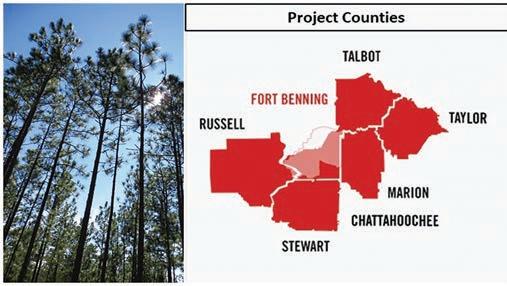
By Dan Weber, The Nature Conservancy
The Kisatchie National Forest (KNF) was recognized by the 2021 Regional Forester’s Honor Awards for the staff’s response to Hurricanes Laura and Delta that hit in 2020 and reshaped portions of the 182,000-acre Calcasieu Ranger District. The District responded by structuring creative sale packages resulting in profit to KNF rather than paying contractors to take away unmerchantable trees. Of the 20,000 acres flattened, almost 13,000 have been salvaged and are now ready for planting longleaf seedlings. As a result, 53,000 cunits (100 cubic feet or ccf) of mostly salvage timber was sold. For these efforts, the Calcasieu District of KNF was recognized as the 2021 ‘Ranger District of the Year.’ Matt Pardue, wildlife biologist on the Vernon Unit of the Calcasieu, was recognized Post-salvage area showing damaged former RCW cavity tree. Photo by Collette DeGarady. for his leadership in reestablishing a red-cockaded woodpecker (RCW) population significantly reduced by the storms. Out of 249 RCW clusters, 224 had at least one tree down, and several had no trees left standing. All total, 851 RCW trees were down or broken off, with many more leaning and unusable. Even with almost 900 RCW trees destroyed, the Vernon population was saved by installing 450 new inserts and associated cluster rehab work. Now, a little more than a year after the storms, clusters are close to pre-storm numbers.
KNF forms the core of the Kisatchie/Fort Polk Significant Geographic Area where the local longleaf implementation team, the West Central Louisiana Ecosystem Partnership, have united to restore longleaf pine and other native ecosystems within a sixparish conservation area.
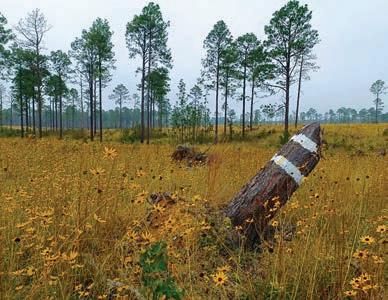
Coastal Headwaters Longleaf Forest Link Added to Florida Wildlife Corridor
By Vernon Compton, GCPEP Director, The Longleaf Alliance
As announced in September 2021, a 2,115-acre parcel within the Coastal Headwaters Longleaf Forest Florida Forever project in Santa Rosa County, Florida, was acquired and added to Blackwater River State Forest. It provides another important link in the statewide wildlife corridor and adds to a wildlife/ecological connection between Naval Air Station Whiting Field and the state forest. This connection has long been a land protection priority of the Gulf Coastal Plain Ecosystem Partnership. Erin Albury, State Forest and Florida Forest Service Director, signified the importance of the project stating, “Blackwater River State Forest is our largest state forest, so the acquisition of this tract will ensure active forest management while preserving the habitat connectivity and the ecosystem.” “The Coastal Headwaters Forest conservation effort aims to protect and restore working longleaf pine habitat in the lower Alabama/Florida Panhandle,” said Lauren Day, The Conservation Fund’s Florida State Director. “The protection of these 2,115 acres in Florida advances this landscape-level initiative, helping to reverse the trend of longleaf pine loss across the Gulf Coastal Plain. We’re honored to partner with the state of Florida, the U.S. Forest Service, the National Fish and Wildlife Service/Walmart, and Resource Management Service, which has a long history of sustainable forest management and Blackwater River State Forest near environmental stewardship. We also thank Florida’s U.S. congressional delegation for RMS Land. Photo by Vernon Compton. their support of the federal Land and Water Conservation Fund, which enabled this important effort.”
“The forests being acquired by the state of Florida have been managed for decades as a working forest, providing wood for societal needs, wildlife habitat, and clean air and water,” said Jimmy Bullock, Senior Vice President of Forest Sustainability at Resource Management Service. “We are honored to collaborate on this unique partnership dedicated to restoring the longleaf ecosystem, benefiting both the environment and the local economy, providing permanent greenspace near strategic military installations and recreational opportunities for the local community.”
Quotes from Florida Department of Environmental Protection Press Release, Tallahassee, Florida.
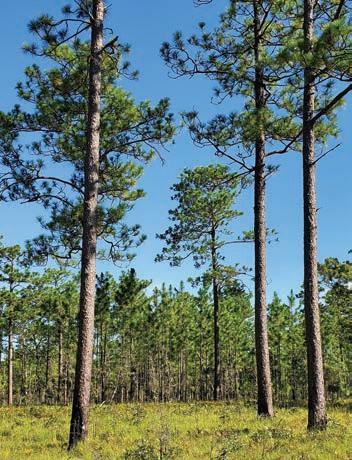
By Susan French, The Longleaf Alliance

Jon Burns, the Georgia House of Representatives Majority Leader, discussed the importance of forestry in the state and the role of prescribed fire.
The first annual Savannah River Fire Festival was held in October 2021 at the Mary Kahrs Warnell Forest Education Center in Effingham County, Georgia. Hosted by The Longleaf Alliance and partners, it was a huge success. The festival was a fun day jam-packed with outdoor activities for approximately 200 attendees, including a live burn demonstration, meet and greets with Burner Bob®, guided nature hikes with Georgia DNR biologists, gopher tortoise burrow explorations, delicious food trucks, and nature-themed face painting. Families and kids learned about natural resource conservation efforts in the Southeast and why prescribed fire is beneficial to people, forests, and wildlife. The festival even made the local Savannah news!
For more information about the Georgia Sentinel Landscape Pilot Project, you can visit longleafalliance.org or contact Project Coordinator Susan French, susan@longleafalliance.org.
Okefenokee/Osceola LIT Boundary Expansion
By Rebecca Shelton, The Nature Conservancy
With the expansion of the Okefenokee-Osceola Local Implementation Team (O2LIT) boundary, it was determined that new and updated objectives on conservation priorities were needed. To set, prioritize and highlight greater restoration support and resource opportunities, a small subcommittee was created. The subcommittee’s goal is to update the O2LIT Charter and Conservation Plan with the new boundary and other new/updated points since its 2016 inception. The subcommittee intends to provide a range-wide framework for longleaf ecosystem conservation. This framework identifies the most significant strategic actions to conserve these systems and serves as a catalyst to further conservation and restoration actions in a strategic and outcome-oriented fashion. The Conservation Plan does not intend to be prescriptive. Instead, it acknowledges that the true work of identifying and addressing specific conservation activities will occur through subsequent efforts, with as many stakeholders as possible working collaboratively under the umbrella of America’s Longleaf Restoration Initiative (ALRI). Current priorities within the O2LIT are to identify additional partners and their programs and initiatives, spatially define areas that have the greatest need of longleaf restoration or are in a maintenance condition, and determine a unified vision for the desired future conditions of the O2LIT. With respect to landowner outreach, the Florida Fish and Wildlife Conservation Commission, in cooperation with The University of Florida's Institute of Food and Agricultural Sciences Extension Office, held another landowner outreach meeting in Baker County, Florida, in November 2021. The purpose of this outdoor meeting was to allow landowners to network and connect with resource professionals. Landowners discussed the cost-share programs offered by the Natural Resources Conservation Service and Best Management Practices. This meeting provided the opportunity to connect to multiple participants, including private owners, land managers, contractors, and conservation partners, potentially influencing restoration on over 45,000 acres of private land.
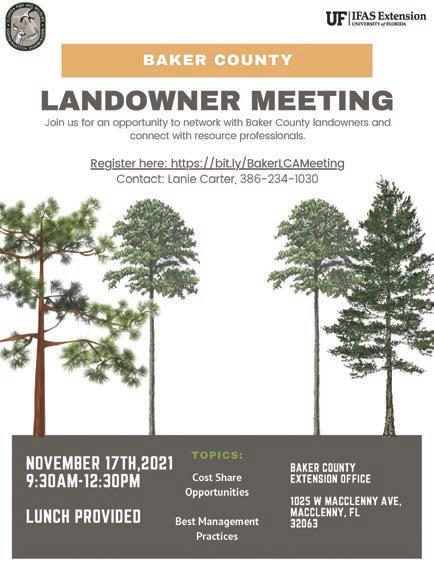
Restoration of Industrial Forests in the SoLo-ACE Landscape - Hamilton Ridge and Palachucola Wildlife Management Areas By Gary Burger, South Carolina Department of Natural Resources
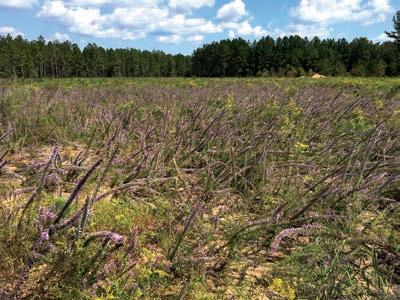
Many longleaf enthusiasts are familiar with South Carolina Department of Natural Resources (SCDNR) Webb Wildlife Center in Hampton County, South Carolina, due to its beautifully maintained, mature longleaf forests that support a significant population of red-cockaded woodpeckers, and a wide array of other important game and non-game species of wildlife. Webb, the former Belmont Plantation, is SCDNR’s oldest wildlife management area (WMA) and countless visitors have enjoyed these longleaf pine forests for 80 years under the state’s ownership. What Left: A former loblolly plantation planted with longleaf pine after some may not be as familiar with are the more recent chemical site prep and prescribed burn on Hamilton Ridge WMA. additions adjacent to the north and south, respectively. Right: An explosion of Liatris and other native vegetation on the same site roughly one year later. What you can’t see are the wonderful surviving young longleaf and the thousands of butterflies. Photos by Gary Burger. Hamilton Ridge WMA was formerly owned by International Paper and Palachucola WMA by MeadWestvaco. Together, the three properties now encompass some 27,000 contiguous acres and miles of river frontage on the lower Savannah River.
It doesn’t take a forester to realize the former industrial landowners planted as much plantation loblolly on the upland areas of these properties as they could. They were, after all, in the fiber production business. But that is changing under SCDNR’s management, and key partners such as The Longleaf Alliance and the Arbor Day Foundation have been instrumental in helping SCDNR restore longleaf to these industrial forests. Wildlife-friendly thinning and prescribed burning are certainly the heavy hitters in managing these “seas” of loblolly pine plantations into open-pine habitat. An increasing number of sites on both properties are selected for clearcut and replanting to longleaf pine each year. Over 1,100 acres have been converted in recent years, with more in the works. One of the most exciting parts of these conversions has been the fantastic response of native understory vegetation on sites that had been industrially managed. Mother Nature is resilient, and with a little helping hand, we can reclaim longleaf habitat even in the most unlikely places.
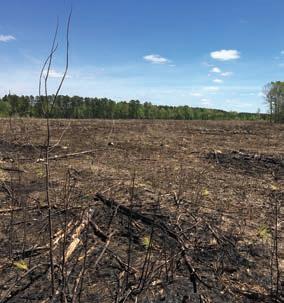
Improving RCW Habitat on Private Lands
By Charles Babb, Sandhills Longleaf Pine Conservation Partnership Coordinator

Thomas Babb uses a chainsaw to remove large hardwoods from around a RCW nest cavity.
The South Carolina Sandhills Longleaf Pine Conservation Partnership began winter maintenance on artificial nest cavities located on three privately owned lands. Twelve artificial cavities were installed in the winter of 2020 to attract red-cockaded woodpeckers from nearby public lands. Sites were initially selected because of the existing habitat, such as a low basal area number, hardwood control, and the use of prescribed fire.
To improve the habitat surrounding the cavities, LIT Coordinator Charles Babb and his son Thomas recently removed all midstory hardwoods within one hundred feet of the cavities by either cutting and herbicide stump treatment or basal bark treatment. These actions reduce nest predation, make cavities more accessible, and increase sunlight to improve sap flow from pitch wells created by the birds.
In the Spring of 2021, the Partnership monitored eight cavities that were used as roost sites, with one nesting pair successfully raising a brood. Cavity monitoring will continue this winter using trail cameras to gather photos of the nesting process, site competition from songbirds, and predators. These photos are used to produce educational materials for youth groups and landowners.
The SLPCP is pursuing similar agreements with additional private landowners to aid red-cockaded woodpecker expansion from public lands onto private parcels.
Private Lands Conservation– Two Generous Actions Protect >7,500 Acres of Longleaf in North Carolina By Hervey McIver, The Nature Conservancy
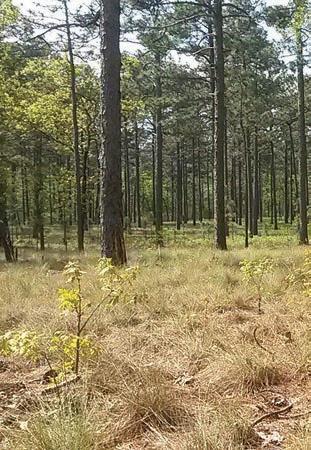
Classic open longleaf pine woodlands are a sight to behold. The majestic beauty that draws us to it as landowners and land managers also inspires others to live among these tall trees. This is the ironic conundrum of conserving well-managed older longleaf stands in areas experiencing rapid human growth; we are susceptible to loving them to death. Fortunately, development will not be the outcome for two significant properties in the North Carolina Sandhills due to generous private protection actions in 2021. The Walthour-Moss Foundation Blue Farm’s longleaf and wiregrass, as far as the eye can see. Horse-drawn cart on The donated a conservation easement on Walthour-Moss Foundation. Photos by Jeff Marcus. 3,946 acres of land to the Forest Legacy Program with the U.S. Forest Service. With additional easements with the NC Department of Transportation and Three Rivers Land Trust, 4,140 acres of this beautiful property are now protected in perpetuity. Ginnie and Pappy Moss created The Foundation in the ‘70s to support equestrian recreation that flourished around Southern Pines, North Carolina. Seeing the region’s rapid growth, The Foundation donated the conservation easement to limit potential future encroachment of roads and infrastructure. This rolling land of beautiful longleaf lies just west of Fort Bragg.
In the 22-year history of the North Carolina Sandhills Conservation Partnership, the Blue Farm has been the top priority for conservation. The Blue family, whose Scottish roots date back to the 1700s, once owned tens of thousands of acres from which they extracted naval stores. The nearly 3,496-acre Blue Farm was acquired in the 1890s, and more recently, has been used for hunting and pine straw production. The land, which supports nine red-cockaded woodpecker clusters, lies in the heart of the critical corridor linking Fort Bragg to Camp Mackall and the Sandhills Game Land. The Nature Conservancy was seeking an arrangement to purchase the property in phases when the family decided to sell the entire property quickly. Fortunately, Tim Sweeney, a North Carolina entrepreneur and dedicated buyer of conservation lands, stepped in and successfully acquired the Blue Farm. Sandhills partners will continue to engage with the Blue Farm’s new management team to support its long-term management and protection, but for now, all conservationists are relieved to see this land in safe hands.
